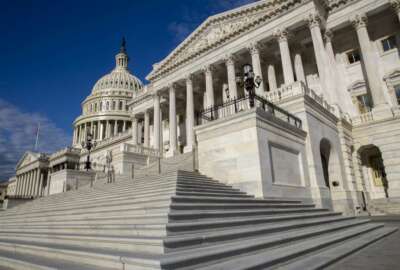
4 things for contractors to remember in planning for a possible government shutdown
Budget experts say it's only prudent for federal contractors to start preparing now for a possible government shutdown on Oct. 1.
With six weeks left in fiscal 2017, budget experts are warning federal contractors that it’s only prudent to begin preparations for the possibility of a government shutdown on Oct. 1.
Lawmakers will have just a few weeks left to develop a budget compromise when they return from August recess before the current spending resolution expires Sept. 30.
House lawmakers passed the Make America Secure Appropriations Act, a “minibus” of spending bills that sets appropriations for the departments of Defense, Energy, Interior, Veterans Affairs and other agencies, as well as the legislative branch. The Senate has passed no appropriations bills yet.
But as budget experts encourage federal contractors to begin preparing for the worst, there is some good news.
Agency contracting officers and senior leadership are more practiced in handling these situations now than they did at the start of the last shutdown in October 2013.
“Because we actually had a real shutdown in 2013 and came within a short period of time of a shutdown in 2015, there’s more experience inside the federal government today than there was in those cases,” David Berteau, president and CEO of the Professional Services Council, said during an Aug. 14 briefing on the possibility of a government shutdown. “You had a lot of people who went through both of these, both in terms of planning and in terms of execution. Unlike 2013 where we hadn’t done it for almost 20 years, we have a lot more experience.”
That means contracting officers may be better equipped now to answer your questions about agencies’ shutdown preparations and how they’ll implement guidance from the Office of Management and Budget — if the government did close, even briefly, on Oct. 1.
But the bad news?
Congress must make a series of difficult decisions within a complicated time frame and under two tight deadlines.
Here are four things that contractors need to know to prepare for the remaining six weeks of the fiscal year.
1. Plan for multiple events
Budget experts were cautious to predict the likelihood of whether Congress would come to an agreement on a spending bill for fiscal 2018 and were even more hesitant to gauge whether the president would sign the bill or a short-term continuing resolution.
But they were firm in their prediction that multiple events may play into lawmakers’ decisions at the end of the fiscal year.
Treasury Secretary Steve Mnuchin on July 28 told congressional leadership he expects the government won’t be able to pay all of its bills on or around Sept. 29 and urged lawmakers to raise Treasury’s borrowing authority.
Several budget experts predict the debt ceiling may play a significant role in upcoming congressional budget negotiations.
If the Treasury Department’s debt ceiling prediction is accurate, the government may reach the debt limit on Friday, Sept. 29.
The last day of fiscal 2017, Sept. 30, falls on a Saturday this year.
“Typically, the government is closed on Saturday and Sunday anyway,” Berteau said. “The calendar adds a little bit of extra uncertainty and could even provide a little bit of a political buffer, simply because you can say, ‘Let’s go slow over Friday, Saturday and Sunday and see if we can get something done by Monday.’ You may well go home on the 29th and not know if you’re coming to work on Monday, Oct. 2.”
2. The implications of the debt limit and a government shutdown differ
If the government reaches the debt ceiling near the end of September and Congress doesn’t find a way to raise the limit, agencies will have restricted access to the funds that are typically available to pay invoices.
“This is a completely different animal,” Alan Chvotkin, executive vice president and counsel for PSC, said of the debt the ceiling.
But existing contracts must continue, and agencies can continue to award most new contracts, task orders and options.
“This is not a stop-work,” Chvotkin said. “This is not a lack of appropriations. If you have a contract, you keep performing. This has no impact on that. It does affect the ability of the government to pay valid invoices. [This is] no small matter, but you can continue to incur the cost and deal with the payment issues as they arise.”
But a default may impact contractors’ ability to get paid.
“You don’t want to be submitting your invoice on the last day,” he said. “To the extent that you have invoices that are sitting and ready to be submitted, I would encourage you to get those invoices in early. The government will only pay valid invoices. They have some cash management procedures that they go through, so getting started on being able to invoice according to your contract as quickly as you can will help.”
Instead, a government shutdown may prompt contractors to stop work immediately on a specific project. Contracts that rely on revolving funds or mandatory spending will largely be safe, but most contracts that depend on annual appropriations may be impacted.
3. Talk to your contracting officer early
Federal contractors should speak with their agency contracting officers sooner rather than later, John Cooney, a partner at Venable law firm, said.
Agency contracting officers will be the point of contact for vendors to learn whether their program is impacted by a shutdown.
Latest Budget News
But contractors shouldn’t expect much prior notice about their agency’s shutdown implementation plans.
“The contracting officer will be in the dark as long as you are,” he said. “He will not know until his political principals tell him, and his political principals won’t know until they get a message from OMB on behalf of the president telling them what the president has decided to do. There will be a lot of confusion, but it’s important to start developing that relationship with a contracting officer as early before the potential shutdown as you can, so that if the shutdown occurs you get your phone call returned faster than other people.”
Beginning a dialogue with a contracting officer sooner rather than later is key, because most agency contracting personnel will get sent home at the start of a government shutdown, Cooney said.
Timing is also important because most shutdown decisions happen early and fast between 2 a.m. and 5 a.m., he added.
“If it turns out that your contract is going to be shut down, you have to figure out how to get that word to your employees, whether you put it up on a website, or for the smaller companies you might be able to call them,” Cooney said.
4. Know where your employees are
Communicating with contracting employees will be a difficult task, as directions from the agency may change at any time.
“It’s a dynamic process,” Cooney said. “It can change from day to day, depending upon which federal employees are furloughed and which federal employees are allowed to report back.”
Company leadership may find that their employees won’t have access to agency buildings or databases, and it may be tough to reach the appropriate contact at the department for more information, Chvotkin said.
Different contracting employees will be in different situations, and vendors should have a plan for each one.
“If the contracting employee work is not at a government facility, you still need to know where they are, you still need to be able to give them guidance because they may be working on a project that is no longer funded and you’ll have to worry about how to recast them,” Chvotkin said. “This is a good time to understand your employment base, know where they are, know how to get in touch with them [and] think about your continuity of operations or other methods by which you can get in touch with your employees.”
Contractors could find other ways to keep their employees busy during a stop-work notice and mitigate the impacts of a shutdown as much as possible. Contractors could ask their employees to work “at risk,” but agencies won’t likely reimburse them for that work.
“You might find that there are other projects that you can productively use that employee on,” Chvotkin said. “It’s certainly appropriate to consider that. Many companies find that if there is a shutdown, it’s a good time to get the employee caught up on some of the mandatory company training. You might encourage the employees to take a vacation, and only as a last resort, would you want to furlough employees.”
Copyright © 2024 Federal News Network. All rights reserved. This website is not intended for users located within the European Economic Area.
Nicole Ogrysko is a reporter for Federal News Network focusing on the federal workforce and federal pay and benefits.
Follow @nogryskoWFED





